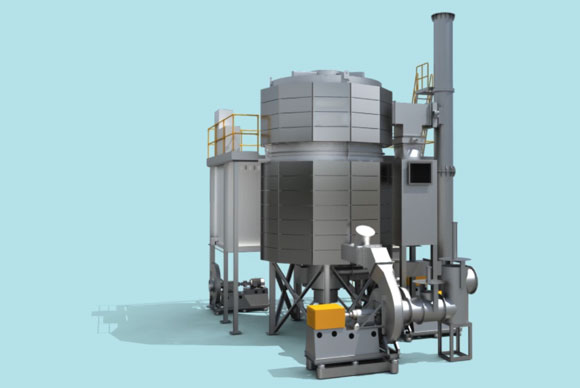What are the best practices for RTO with heat recovery in the food processing industry?
Regenerative Thermal Oxidizers (RTO) are a popular air pollution control technology that can significantly reduce air emissions from industrial processes. In the food processing industry, RTOs can be used to destroy volatile organic compounds (VOCs) and odors that are released during various manufacturing processes. However, RTO systems can be energy-intensive, and the costs associated with operating them can be high. To address these challenges, many food processing facilities have begun implementing RTO systems with heat recovery capabilities. In this article, we will explore the best practices for RTO with heat recovery in the food processing industry.
1. Understanding the Basics of RTO with Heat Recovery
Before implementing RTO with heat recovery, it is essential to understand the basics of how the system works. An RTO with heat recovery utilizes a ceramic media bed to absorb and store heat generated by the oxidation process. This stored heat is then used to preheat incoming process air, reducing the amount of fuel required to sustain the oxidation reaction. The heat recovery process can significantly reduce the operating costs of an RTO system by reducing the amount of natural gas or other fuel needed to operate the system.
2. Choosing the Right Type of RTO with Heat Recovery
When selecting an RTO system with heat recovery for a food processing facility, it is crucial to consider the specific requirements of the manufacturing process. The type of RTO system chosen should be appropriate for the volume and type of emissions generated by the process. Additionally, the RTO system should be designed to handle the specific temperature and humidity conditions of the process air.
3. Proper Maintenance and Inspection of the RTO System
To ensure that an RTO system with heat recovery operates efficiently and effectively, it is vital to perform regular maintenance and inspections. Maintenance activities may include cleaning the ceramic media bed, inspecting the combustion chamber and heat exchanger, and replacing damaged or worn components. Regular inspections can help identify potential issues before they become significant problems, helping to minimize downtime and repair costs.
4. Implementing a Comprehensive Monitoring and Control System
A comprehensive monitoring and control system is critical for ensuring that an RTO system with heat recovery operates efficiently and at peak performance. This system should include sensors and controls that monitor emissions, temperature, pressure, and other critical operating parameters. The monitoring and control system can be integrated with the facility’s existing process control system, allowing for real-time monitoring and adjustment of the RTO system’s operations.
5. Utilizing Modern Technologies and Innovations
The food processing industry is constantly evolving, and new technologies and innovations can improve the efficiency and effectiveness of RTO systems with heat recovery. For example, modern RTO systems may include features such as regenerative burners, which can further reduce energy consumption by recycling heat from the exhaust gases. Additionally, advances in control systems and automation can help optimize the operation of the RTO system, further reducing energy consumption and improving performance.
6. Ensuring Compliance with Regulatory Requirements
Finally, it is essential to ensure that an RTO system with heat recovery complies with all relevant regulatory requirements. Compliance may include obtaining air permits, conducting regular emissions testing, and adhering to specific reporting requirements. Failure to comply with regulatory requirements can result in significant fines and legal penalties, as well as damage to the facility’s reputation.

7. Conclusion
In summary, RTO systems with heat recovery can help food processing facilities reduce air emissions and operating costs. To ensure that these systems operate efficiently and effectively, it is essential to understand the basics of the technology, choose the right system for the manufacturing process, perform regular maintenance and inspections, implement a comprehensive monitoring and control system, utilize modern technologies and innovations, and ensure compliance with regulatory requirements.
We are a high-tech enterprise specializing in the comprehensive treatment of volatile organic compounds (VOCs) waste gas and carbon reduction and energy-saving technology for high-end equipment manufacturing. Our core technical team comes from the Aerospace Liquid Rocket Engine Research Institute (Aerospace Sixth Institute); it has more than 60 R&D technicians, including 3 senior engineers at the researcher level and 16 senior engineers. It has four core technologies: thermal energy, combustion, sealing, and automatic control; it has the ability to simulate temperature fields and air flow field simulation modeling and calculation; it has the ability to test the performance of ceramic thermal storage materials, the selection of molecular sieve adsorption materials, and the experimental testing of the high-temperature incineration and oxidation characteristics of VOCs organic matter. The company has built an RTO technology research and development center and an exhaust gas carbon reduction engineering technology center in the ancient city of Xi’an, and a 30,000m122 production base in Yangling. The production and sales volume of RTO equipment is far ahead in the world.
¹«Ë¾¼òÒª½éÉÜ
ÎÒÃÇÊÇÒ»¼Ò¸ß¿Æ¼¼ÆóÒµ£¬×¨×¢ÓÚ»Ó·¢ÐÔÓлúÎï(VOCs)·ÏÆøµÄ×ÛºÏÖÎÀíºÍ̼¼õÅÅÓë½ÚÄܼ¼Êõ¡£ÎÒÃǵĺËÐļ¼ÊõÍŶÓÀ´×Ôº½¿ÕÒºÌå»ð¼ý·¢¶¯»úÑо¿Ëù(º½ÌìÁùÔº)£¬ÓµÓÐ60ÓàÃûÑз¢¼¼ÊõÈËÔ±£¬ÆäÖаüÀ¨3ÃûÑо¿Ô±¼¶¸ß¼¶¹¤³ÌʦºÍ16Ãû¸ß¼¶¹¤³Ìʦ¡£ÎÒÃÇÓµÓÐÈÈÄÜ¡¢È¼ÉÕ¡¢ÃÜ·âºÍ×Ô¶¯¿ØÖÆËÄ´óºËÐļ¼Êõ£»¾ß±¸Ä£Äâζȳ¡ºÍÆøÁ÷³¡·ÂÕ潨ģºÍ¼ÆËãµÄÄÜÁ¦£»¾ß±¸ÌÕ´ÉÐîÈȲÄÁÏÐÔÄܲâÊÔ¡¢·Ö×ÓɸÎü¸½²ÄÁÏÑ¡ÔñÒÔ¼°VOCsÓлúÎï¸ßηÙÉÕºÍÑõ»¯ÌØÐÔµÄʵÑé²âÊÔÄÜÁ¦¡£¹«Ë¾ÔÚÎ÷°²¹Å³Ç½¨Á¢ÁËRTO¼¼ÊõÑз¢ÖÐÐĺͷÏÆø̼¼õÅŹ¤³Ì¼¼ÊõÖÐÐÄ£¬²¢ÔÚÑîÁ轨Á¢ÁËÒ»¸ö30,000m2µÄÉú²ú»ùµØ¡£RTOÉ豸µÄ²úÏúÁ¿ÔÚÈ«Çò´¦ÓÚÁìÏȵØλ¡£
Ñз¢Æ½Ì¨
- ¸ßЧȼÉÕ¿ØÖƼ¼ÊõÊÔÑę́
- ·Ö×ÓɸÎü¸½Ð§ÄÜÊÔÑę́
- ¸ßЧÌÕ´ÉÐîÈȼ¼ÊõÊÔÑę́
- ³¬¸ßÎÂÓàÈÈ»ØÊÕÊÔÑę́
- Æø̬Á÷ÌåÃÜ·â¼¼ÊõÊÔÑę́
¸ÃÊÔÑę́¾ß±¸¸ßЧȼÉÕ¿ØÖƼ¼ÊõµÄÑз¢ºÍ²âÊÔÄÜÁ¦£¬¿É±£Ö¤·ÏÆø´¦ÀíÉ豸µÄ¸ßЧÐÔºÍÎȶ¨ÐÔ¡£
¸ÃÊÔÑę́¿É²âÊÔºÍÆÀ¹À·Ö×ÓɸÎü¸½²ÄÁϵÄÎü¸½Ð§ÄÜ£¬±£Ö¤·ÏÆø´¦ÀíÉ豸µÄÎü¸½Ð§¹û¡£
¸ÃÊÔÑę́¿É²âÊÔºÍÑз¢¸ßЧÌÕ´ÉÐîÈȲÄÁÏ£¬Ìá¸ß·ÏÆø´¦ÀíÉ豸µÄÄÜÁ¿»ØÊÕЧÂÊ¡£
¸ÃÊÔÑę́¿ÉÒÔ¶Ô³¬¸ßÎÂÓàÈÈ»ØÊÕ¼¼Êõ½øÐÐÑо¿ºÍ²âÊÔ£¬ÊµÏÖ·ÏÆø´¦ÀíÉ豸µÄÄÜÁ¿»ØÊÕºÍÔÙÀûÓá£
¸ÃÊÔÑę́¾ß±¸Æø̬Á÷ÌåÃÜ·â¼¼ÊõµÄÑз¢ºÍ²âÊÔÄÜÁ¦£¬È·±£·ÏÆø´¦ÀíÉ豸µÄ°²È«ºÍÎȶ¨¡£

רÀûÓëÈÙÓþ
ÎÒÃÇÔÚºËÐļ¼ÊõÉÏÉ걨ÁË68ÏîרÀû£¬ÆäÖаüÀ¨21Ïî·¢Ã÷רÀû£¬»ù±¾¸²¸ÇÁ˹ؼü²¿¼þ¡£ÒÑ»ñÊÚȨµÄרÀû°üÀ¨4Ïî·¢Ã÷רÀû¡¢41ÏîʵÓÃÐÂÐÍרÀû¡¢6ÏîÍâ¹ÛרÀûºÍ7ÏîÈí¼þÖø×÷Ȩ¡£

Éú²úÄÜÁ¦
- ¸Ö°å¡¢ÐͲÄ×Ô¶¯Å×ÍèÅçÆáÉú²úÏß
- ÊÖ¶¯Å×ÍèÉú²úÏß
- ³ý³¾»·±£É豸
- ×Ô¶¯ÅçÆá·¿
- ºæ¸É·¿
¸ÃÉú²úÏ߾߱¸¸Ö°åºÍÐͲĵÄ×Ô¶¯Å×ÍèÅçÆáÄÜÁ¦£¬±£Ö¤²úÆ·±íÃæµÄÖÊÁ¿ºÍÍ¿²ãµÄÕ³¸½Á¦¡£
ÊÖ¶¯Å×ÍèÉú²úÏß¿ÉÂú×ãÌØÊâ²úÆ·µÄÅ×ÍèÐèÇ󣬱£Ö¤²úÆ·±íÃæµÄÇå½à¶ÈºÍÖÊÁ¿¡£
ÎÒÃÇÉú²úµÄ³ý³¾»·±£É豸¿ÉÒÔÓÐЧ¾»»¯·ÏÆø£¬±£»¤»·¾³ºÍÈËÀཡ¿µ¡£
×Ô¶¯ÅçÆá·¿¾ß±¸×Ô¶¯»¯ÅçÆáÉ豸ºÍ»·¾³¿ØÖÆϵͳ£¬±£Ö¤²úÆ·ÅçÆáÖÊÁ¿ºÍÉú²úЧÂÊ¡£
ÎÒÃǵĺæ¸É·¿¾ß±¸ÏȽøµÄºæ¸ÉÉ豸ºÍÎÂʪ¶È¿ØÖÆϵͳ£¬¿ÉÂú×ã¸÷ÖÖ²úÆ·µÄºæ¸ÉÐèÇó¡£

ÎÒÃǺôÓõ¿Í»§ÓëÎÒÃǺÏ×÷£¬ÒòΪÎÒÃÇÓÐÒÔÏÂÓÅÊÆ£º
- ·á¸»µÄÑз¢¾ÑéºÍ¼¼ÊõʵÁ¦
- ÁìÏȵĺËÐļ¼ÊõºÍרÀû±£»¤
- ÏȽøµÄÉú²úÉ豸ºÍÉú²úÄÜÁ¦
- ¸ßЧµÄ·ÏÆø´¦ÀíºÍ̼¼õÅŽâ¾ö·½°¸
- È«ÃæµÄÊÛºó·þÎñºÍ¼¼ÊõÖ§³Ö
- »ý¼«ÏìÓ¦»·±£Õþ²ß£¬Ìṩ¿É³ÖÐø·¢Õ¹½â¾ö·½°¸

Автор: Мия
